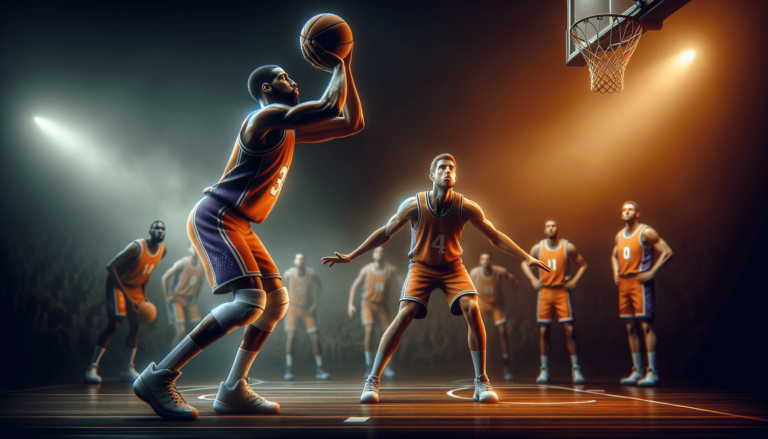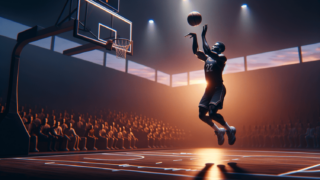
One-and-One Free Throw Rule in Basketball: Explained
Written by: Basketball Universe
Last updated:

Welcome to the exciting world of basketball! In this blog post, we will be exploring the mysterious and critical realm of the one-and-one free throw rule. If you’ve ever found yourself scratching your head over a game’s sudden momentum shift or puzzled about a player’s strategic move at the free throw line, buckle up because we’re about to break it all down. Our mission is to satisfy the curiosity of every basketball enthusiast out there by thoroughly (and entertainingly) deconstructing the one-and-one free throw rule, chapter by chapter. With a fun, professional, and insightful approach, we’ll demystify this pivotal piece of the basketball puzzle for you!
One-and-One Free Throw Rule in Basketball: Explained
The one-and-one free throw rule in basketball is a situation when a player is awarded a single free throw after an opposing team has committed a certain number of fouls (typically 7 fouls in college and 8 fouls in FIBA). If the shooter makes the first free throw, they earn a second attempt. However, if they miss, the ball becomes live, potentially leading to a rebound battle. This rule helps balance the game by penalizing excessive fouling while adding strategic depth, as teams and players must decide when and how to take advantage of the one-and-one scenario.
Understanding the Crux of One-and-One Free Throw Rule
Before we dive into the depths of the one-and-one free throw rule, it’s essential to have a clear understanding of free throws and fouls in general. A free throw is an unopposed shot from the free-throw line, awarded to a player who has been fouled. Depending on the type of foul committed, a player might be awarded one, two, or three free throws. A foul typically involves illegal physical contact between players or violations of basketball rules.
The Genesis of the One-and-One Rule
The one-and-one free throw rule is attributed to the number of non-shooting fouls committed by the defensive team during a specific period of the game. Basketball rules dictate that when a team accumulates a certain number of team fouls within a half (in college) or a quarter (in FIBA), they enter a penalty situation called the “bonus” or “one-and-one” scenario.
In NCAA college basketball, teams reach the bonus once they’ve committed their seventh team foul in a half. The fouled player then gets a one-and-one free throw opportunity. If they make the first free throw, they are awarded a second attempt. The rule changes slightly in FIBA games, where the one-and-one situation begins on the opposing team’s eighth foul in a quarter.
The intent behind the one-and-one free throw rule is to discourage excessive or deliberate fouling while adding an interesting strategic layer to basketball games.
Strategies Surrounding the One-and-One Free Throw Rule
Coaches and players employ various tactics to maximize their advantages during a one-and-one free throw situation. Let’s explore some of these strategies and how they impact the game.
The Art of Choosing the Right Fouling Targets
Teams often use the one-and-one scenario to intentionally foul weaker free-throw shooters, hoping that they will miss the first attempt and forfeit the opportunity for a second shot. This tactic, known as “Hack-a-Shaq” or “Hack-a-player,” forces the opposing team to reconsider their lineup as the fouled player’s free-throw shooting skills become a liability in tight games.
Defensive Adjustments and Foul Troubles
The impending one-and-one situation often dictates shifts in defensive strategies, as teams look to avoid reaching the bonus and giving their opponents easy scoring opportunities. Entering foul trouble can lead to more conservative player choices or an increased focus on positioning and help defense to minimize the risk of committing further fouls.
Importance of Rebounding and Clock Management
Since a missed one-and-one free throw results in a live ball, rebounding becomes a critical aspect of the game. Teams must ensure they’re in position to secure the rebound, gaining possession after a missed one-and-one attempt. In close games or during late-game situations, clock management also comes into play. Wasting fewer seconds by stopping the clock with fouls, taking advantage of the one-and-one rule, and controlling the pace can significantly impact the final outcome.
One-and-One Free Throw Rule in Different Leagues
Basketball is played and loved worldwide, and with this immense popularity come variations in basketball rules across different leagues. Let’s take a look at how the one-and-one free throw rule is applied in some of the major basketball organizations.
One-and-One in NCAA College Basketball
In NCAA men’s and women’s college basketball, the one-and-one free throw rule applies after a team commits their seventh, eighth, and ninth team fouls within a half. When they reach the tenth team foul, the opposing team is awarded two free throws (referred to as “double bonus”) instead of a one-and-one opportunity.
One-and-One in FIBA Games
In FIBA games, the one-and-one rule is activated once a team accrues eight team fouls in a quarter. The opposing team then gets a one-and-one free throw chance. However, unlike NCAA basketball, there’s no “double bonus” scenario in FIBA games. So, as long as the team stays below the threshold of five fouls, they don’t have to worry about one-and-one free throws.
One-and-One in NBA and WNBA
Contrary to popular belief, there is no one-and-one free throw rule in the NBA or WNBA. In both leagues, once a team exceeds the limit of four team fouls in a quarter, all subsequent non-shooting fouls result in the opposing team being awarded two free throws. This is commonly referred to as the “penalty” situation.
Impact of the One-and-One Free Throw Rule on Basketball
The one-and-one free throw rule significantly impacts basketball games by adding strategic elements, increasing the level of excitement for fans, and shaping player development.
Strategy Component
One of basketball’s appeals is the strategic depth that the one-and-one rule adds to the game. Teams must decide when and where to commit fouls, pick their targets, and adjust their defense accordingly. The one-and-one rule also forces teams to make crucial decisions about personnel, often needing to choose between a player’s ability to score and their free-throw shooting competency.
Audience Excitement
Close games are undoubtedly thrilling to watch, and one-and-one free throw scenarios can heighten the excitement. Missed free throws or clutch rebounds during the one-and-one bonus situations can turn the tide, leading to tense moments and dramatic finishes.
Player Development
The one-and-one rule underscores the importance of developing a complete skill set as a basketball player. Both offensive and defensive players must sharpen their free-throw shooting abilities to capitalize on one-and-one opportunities and avoid becoming a liability in crucial situations. Furthermore, the rule places a premium on rebounding, demanding that every player on the court contribute to this essential aspect of the game.
Historic Moments Involving the One-and-One Rule
Now that we’ve gained a better understanding of the one-and-one free throw rule, let’s revisit some memorable moments in basketball history where this pivotal rule played a starring role.
Chris Webber’s Timeout Mistake in the 1993 NCAA Championship Game
Trailing by two points against North Carolina in the 1993 NCAA Championship game, Michigan’s Chris Webber rebounded a missed one-and-one free throw with 19 seconds remaining. In the ensuing chaos, Webber mistakenly called a timeout when his team had none left, resulting in a technical foul. This sealed Michigan’s loss, illuminating the importance of understanding the one-and-one rule and strong mental presence.
Gonzaga’s 2019 Elite Eight Victory Against Texas Tech
In the 2019 NCAA tournament, Gonzaga’s Josh Perkins committed an undisciplined foul after a missed one-and-one free throw by Texas Tech. Perkins instinctively tried to stop the clock, not realizing his team still had one foul to give. As a result, Texas Tech was awarded a one-and-one free throw opportunity, which ultimately contributed to Gonzaga’s loss, showcasing the risks of late-game foul decisions.
Conclusion
Mastery of the one-and-one free throw rule is crucial for basketball players, coaches, and fans alike. It adds strategic depth, helps balance the game by preventing excessive fouling, and offers thrilling moments in basketball history. Stay up to date on the different leagues’ specific regulations and always remember the significance of the one-and-one rule in shaping the outcome of a game.
Free Throw Techniques in One-and-One Situations
As we’ve established, the one-and-one free throw rule can drastically influence the outcome of a game. Here, we’ll discuss some tips and techniques both for the shooter and the teammates at the free throw line to optimize success in one-and-one situations.
Mental Preparation for the Shooter
One-and-one free throw situations can put immense pressure on the shooter. Preparing mentally and handling that pressure is crucial for success. Shooters should focus on their routine, stay calm, visualize the shot’s success, and block out external distractions. Maintaining a consistent pre-shot routine across all free throws aids muscle memory and helps keep consistency in high-pressure moments.
Proper Execution of the Shot
Shooting techniques can vary among players, but some fundamental principles apply to every successful free throw. Shooters should have proper balance and stance, align their body with the basket, and use their legs to generate power. A smooth release, steady follow-through, and soft touch are also essential in sinking a one-and-one free throw.
Teammate Support and Rebounding Prowess
Teammates on the court during a one-and-one free throw play a vital role in securing a positive outcome. They should encourage and support the shooter, while simultaneously focusing on positioning and tactics for the imminent rebound. The players’ ability to box out opponents, anticipate the ball’s trajectory, and secure the rebound, whether offensively or defensively, can be game-changing in one-and-one scenarios.
Statistics and the One-and-One Free Throw Rule
Statistics can speak volumes about the significance of the one-and-one free throw rule in basketball. Better understanding the available data can assist coaches and players in making more informed in-game decisions.
Free Throw Percentage and Its Implications
Free throw percentage (FT%) is a key metric that can guide coaches when considering strategies surrounding the one-and-one free throw rule. A player with a high FT% can be a valuable asset in one-and-one scenarios, while a low FT% can be detrimental to the team’s success. Coaches should be familiar with their players’ FT% and even the FT% of opponents to make informed decisions regarding lineups, intentional fouling, and late-game strategies.
Impact of Home Court Advantage
One fascinating aspect of the one-and-one rule is the potential impact of playing at home or away. Studies have shown that crowd noise and familiarity with the venue can significantly influence free throw performance. Coaches should consider these factors when devising strategies for one-and-one situations, taking full advantage of their knowledge of individual players and their ability to perform under various conditions.
One-and-One Free Throw Rule: Understanding the Myths and Misconceptions
As with any complex rule in sports, there are always myths and misconceptions surrounding the one-and-one free throw rule. Uncovering the truth behind these misconceptions can lead to more informed decisions and a better appreciation for the sport.
Myth: Intentional Misses are Always Advantageous
One myth prevalent among fans and players is the idea that intentionally missing a one-and-one attempt can provide an offensive edge by catching the defense off guard. While there are rare occasions where this tactic might be useful, such as when the clock is winding down and the team is trailing by more than two points, in most situations, attempting the best free throw shot possible will yield a better outcome.
Myth: An Opponent Can Block a Free Throw Attempt
Another misconception revolves around the legality of blocking a free throw attempt. According to basketball rules, a defensive player cannot block or make contact with the ball on its way to the basket during a free throw. If contact is made, it will result in a goaltending violation, awarding the points to the shooting team. Ensuring that all players understand this rule can prevent unnecessary violations and ensure a fair competition.
FAQ: One-and-One Free Throw Rule in Basketball
Have some burning questions about the one-and-one free throw rule? Fret not! We’ve put together a list of frequently asked questions and answers on this topic that’ll surely satisfy your curiosity.
1. What is the one-and-one free throw rule?
The one-and-one free throw rule is activated when a team has committed a specific number of non-shooting fouls. It awards a single free throw opportunity to an opposing player who has been fouled. If the first free throw is successful, a second attempt is given; if it’s missed, the ball becomes live, opening the door for a potential rebound.
2. How many team fouls are needed to trigger the one-and-one rule in college basketball?
In NCAA college basketball, the one-and-one rule comes into effect after the defensive team commits their seventh team foul in a half. The rule applies for the seventh, eighth, and ninth team fouls.
3. How does the one-and-one rule apply in international FIBA games?
In FIBA games, the one-and-one rule is triggered after a team accumulates eight team fouls in a quarter. There is no “double bonus” rule as seen in NCAA basketball, meaning teams always receive a one-and-one opportunity when fouled, regardless of the number of fouls committed.
4. Is there a one-and-one free throw rule in the NBA and WNBA?
No, the NBA and WNBA do not have a one-and-one free throw rule. Instead, all non-shooting fouls after the fourth team foul in a quarter lead to two free throws for the opposing team, a situation commonly referred to as the “penalty” scenario.
5. What are some strategic implications of the one-and-one rule?
The one-and-one free throw rule adds strategic depth to basketball, affecting decisions on fouls, rebounds, clock management, and player lineup choices. Coaches and players must constantly adapt their tactics based on the one-and-one situation to maximize their competitive advantages.
6. How can a shooter improve their performance in one-and-one free throw scenarios?
A shooter can improve their success in one-and-one situations by focusing on mental preparation, maintaining a consistent pre-shot routine, and employing proper shooting techniques such as balance, body alignment, leg power, smooth release, and follow-through.
7. How do free throw percentage statistics impact decision-making in one-and-one situations?
Free throw percentage (FT%) can guide coaches in determining lineups, intentional fouling targets, and late-game strategies. A player’s FT% can indicate their likelihood of success in one-and-one scenarios, helping coaches make informed game decisions.
8. What is the “double bonus” rule in NCAA basketball?
The “double bonus” rule in NCAA basketball activates once a team commits their 10th team foul in a half. Instead of a one-and-one free throw opportunity, the fouled player is awarded two guaranteed free throws for any additional non-shooting fouls.
9. Can the opponents block a free throw attempt?
No, opponents cannot block or make contact with the ball on its way to the basket during a free throw. If contact occurs, it will result in a goaltending violation, and the shooting team will be awarded the points.
10. Why is rebounding critical in one-and-one free throw scenarios?
Rebounding is crucial in one-and-one situations because a missed first attempt results in a live ball. Being alert and securing the rebound in these scenarios can significantly impact the game, particularly in late-game or tight situations.
Featured Posts
- No pillar pages found.





